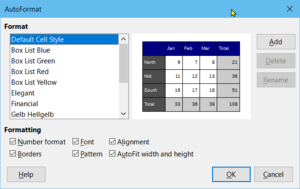AutoFormat Table Styles
TDF LibreOffice Document Liberation Project Community Blogs Weblate Nextcloud Redmine Ask LibreOffice Donate
Foreword
Basis of this description and the video is the Online help function and the documentation of LibreOffice.
The video "AutoFormat Tabellenvorlagen - LibreOffice" links to this page here, which contains further information and details.
The procedure and menu navigation is partly different in Calc and Writer.
Link to the Video
Link to the Video (in German [DE]):
AutoFormat for tables (short form)
Automatically applies format settings to the current table, including fonts, background and borders.
To access the command:
- Place the cursor in the table
- Select ▸ from the menu.
To format a table automatically
- Click in a table cell or select the cells to format.
- Choose ▸ and then click on the format you want to assign.
- Click .
Options in the "AutoFormat" dialog
Format
Displays a list of available Styles for tables.
Click the required format, and then click .
Add
Adds a new Table Style to the list.
- Select the entire table, then choose ▸ .
- Click .
- In the "Add AutoFormat" dialog, enter a name, then click .
Delete
Deletes the selected Table Styles.
You cannot delete the "Default Table Style".
Rename
Changes the name of the selected Table Style.
You cannot rename the "Default Table Style".
Formatting
Select the formatting attributes to be applied to the Table Style.
Number format
Includes number formats in the selected Table Style.
Font
Includes the font in the selected Table Style.
Alignment
Includes the alignment in the selected Table Style.
Outlines
Includes borders in the selected Table Style.
Pattern
Includes background patterns in the selected Table Style.
AutoFit width and height
Includes the function that automatically adjusts the width and height of the cells (only in Calc).
Apply AutoFormat Styles
Tables should often look representative.
Doing this manually each time, especially if you have to create tables frequently, is very time-consuming.
To simplify this work, you can use the "AutoFormat Styles" function to automatically apply desired formats to a table or a selected cell range.
Select cells in Calc
Select at least 4 x 4 cells, or larger - the size of the table as it will be later, including the required column and row headings and totals to be formatted automatically.
Then select ▸ .
Select cells in Writer
Select the cells in the table, including the required column and row headings and totals, to be automatically formatted.
Then select ▸ .
Definitions in the "AutoFormat" dialog
In the "AutoFormat" dialog you can now select which format - ("Number format", "Font", "Alignment", "Borders", "Pattern" and in Calc "AutoFit with and hight") - you wish to include in the AutoFormat.
Select the desired "Formatting" and click on .
Redefine an AutoFormat Styles
If you don't like any of the given formats, you can also create a format yourself.
To do this, format an area on the spreadsheet of at least 3 times 3 cells, or larger, as large as the spreadsheet is to be later, including the headings for rows and columns and the display of totals.
Now you define all details for the Style.
This includes the font and font size, alignment, border, number format and colours.
When the table is complete, select the entire table area and choose ▸ in Calc or ▸ in Writer.
In the "AutoFormat" dialog click .
In the "Add AutoFormat" dialog that opens, enter a Name (e.g. "Format_01") for a new format and click .
The newly created format, "Format_01", is now displayed in the "AutoFormat" dialog, on the left side of the list with the name.
You close the dialog with .
You can now use the new format "Format_01".
Value Highlightning
"Value Highlightning" in Calc shows the contents of the cells in different colours depending on the type.
Choose ▸ from the menu bar or press Ctrl+F8.
By default, text cells are formatted in black, formulas in green, number cells in blue.
Protected cells are displayed with a light grey background, no matter how their display is formatted.
Sidebar - Styles / Table Styles in Writer
The sidebar ( F11 ) displays the Table Styles that are also in the list in the "AutoFormat" dialog.
Once you have added a new AutoFormat Style, it is also selectable in the sidebar for Table Styles.
So you can also mark a table and assign the desired Table Style with a double click.
Further information
File
Description of this Wiki page as a file (in German [DE]):
Beslægtede emner
Documentation / Manuals
Here you will find the Documentation / Manuals:
Any more questions?
For questions on this topic go to:
Get Involved
Join us today and help us to make it even better!
Donate
LibreOffice is Free Software and is made available free of charge.
Your donation, which is purely optional, supports our worldwide community.
If you like the software, please consider a Donation.
